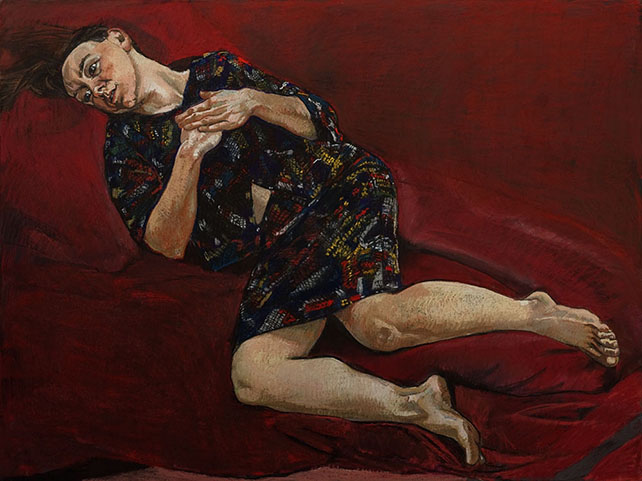Paula Rego (1935) is a Portuguese artist known for her paintings and prints which are often based on children’s folktales. A “painter of stories” celebrated for her dark, complex paintings, prints, drawings, and collages, Paula Rego draws upon folk- and fairytales, literature, and her own biography to create politically charged, deeply unsettling tableaux. Her forceful compositions are imbued with cruelty—both subtle and overt—and permeated with a sense of unease and ambiguity. Foregrounding women and girls, and often using animals as stand-ins for humans, she depicts dysfunctional family relationships, political systems (like that of Portugal’s António de Oliveira Salazar), and social structures. Rego is fascinated by what she calls “the beautiful grotesque” in life and in art. As she describes: “It’s the divine, perhaps. I mean some other kind of divine, which connects very strongly to Portuguese folk tales and stories—the strength of them and, very often, the enormous cruelty involved. The cruelty is fascinating.”
Among her most famous works are her Dog Women paintings, a playful series depicting a magical realist world where women behave as dogs. Rego’s work is heavily influenced by Surrealist artists like Joan Miró, though gradually her paintings have become more realistically rendered with similarities to the work of the painter Balthus in their strong, clear drawing style and depictions of women in strange or unsettling situations. Born in Lisbon, Portugal, she went on to study in London at the Slade School of Fine Art.
Note: all artwork are copyright © Paula Rego
 |
| Mrs Paula Rego |
 |
| Jenufa |
 |
| 1960, Order has been Established |
 |
| 1960, Trophy |
 |
| 1961, When we had a House in the Country |
 |
| 1964, Centaur |
 |
| 1966, The Firemen of Alijo |
 |
| 1981, Cat & Guinea Pig |
 |
| 1981, Red Monkey Beats his Wife |
 |
| 1982, Lessons |
 |
| 1983, Jenufa II |
 |
| 1983, La Traviata |
 |
| 1983, Rigoletto |
 |
| 1984, The Vivian Girls in Tunisia |
 |
| 1985, The Drowned Bear |
 |
| 1987, Looking Back |
 |
1987, The policemanr's daughter
In the late 1980’s Paula Rego made a series of painting to explore close family relationships. All the relationships seem somewhat dysfunctional, particularly those between the fathers and the daughters. The Policeman’s Daughter is angry, her hand rammed into her father’s boot as she cleans it, a drawing for the painting shows its genesis in a relationship that is a little more innocent – a younger girl, cradling the boot as she cleans it, a toy castle symbolising security at her feet. In the painting, the castle has become a mistrustful cat, and the pose of the girl, taken from a sexually-explicit Robert Mapplethorpe photograph, anything but innocent. |
 |
| 1987, The soldier's daughter |
 |
| 1988, Drawing for 'The Dance'' |
 |
| 1988, The Dance |
 |
| 1989, Little Miss Muffet (I) |
 |
1989, The Fitting
Born in Portugal, Paula Rego’s work always has a sense of magical realism; quirky contemporary mythologies pointing to an underlying psychology and sexuality, through a feminine view point. The Fitting is a scene of fairytale romance turned nightmare. Reminiscent of Velasquez’ Las Meninas, Paula Rego uses loaded imagery and symbolism to create a surreal mystery for the unravelling. |
 |
| 1994, Bad Dog |
 |
| 1994, Bride |
 |
| 1994, La Grange (The barn) |
 |
1995 Dancing Ostriches from Disney's 'Fantasia'
They are Harpies, Homer's personified storm winds who carry the unprepared into oblivion. In the dog women series, which preceded them, there was always a story, a male presence implied though never seen. But with The Ostriches there is no story; no man (or child) is present or implied. The ostrich women may tempt or pursue men, but these are pictures of states of mind rather than narration; the most 'abstract', in the imaginative sense, of her career so far. | |
 |
| 1995, Dancing Ostriches (triptych) left panel |
 |
| 1995, Dancing Ostriches (triptych) right panel |
 |
| 1995, Love |
 |
| 1995, Snow White and her Stepmother |
 |
| 1995, Target |
 |
| 1996, A Concise Definition of Answers |
 |
| 1996, Flood |
 |
| 1996, Him |
 |
| 1996, Mist I |
 |
| 1996, Straw Burning |
 |
| 1997, Fire tale |
 |
| 1997, Looking Out |
 |
| 1997, The Company of Women |
 |
| 1998, Three Blind Mice II |
 |
| 1999, The Betrothal Lessons The Shipwreck, after 'Marriage a la Mode' |
 |
| 1999, The Shipwreck, after Marriage a la Mode |
 |
2000-01, Celestina's House
Paula Rego paints a world of dark fairy tale where childhood stories are thin guises for psycho-sexual intrigue and taboo, where magical realism rules, where nothing is certain except the witchy powers of feminism, and the underlying notion that nothing is as it seems.
The picture begins with the story of Celestina, a character who appears in Spanish literature in the late fifteen century. Celestina was a procuress and Paula Rego draws her as she draws all her women – tough, practical, ruthless. The picture uses the story of Celestina to explore the ages of women, although as Paula Rego wryly comments, if there are seven ages of woman as of man, then her Celestina has already lived through at least thirteen. |
 |
| 2000, after Hogarth |
 |
| 2002, Pieta |
 |
| 2003, The little mermaid |
 |
| 2003, War |
 |
| 2006, Scarecrow |
 |
| 2011, Painting Him Out |
 |
| 2011, The Balzac Story |



















































No comments:
Post a Comment